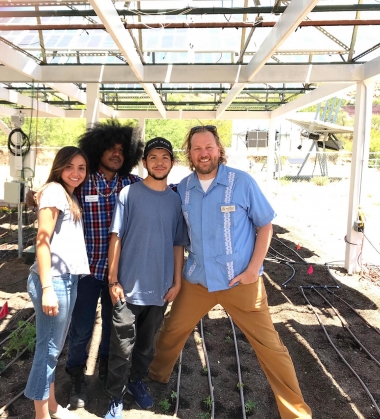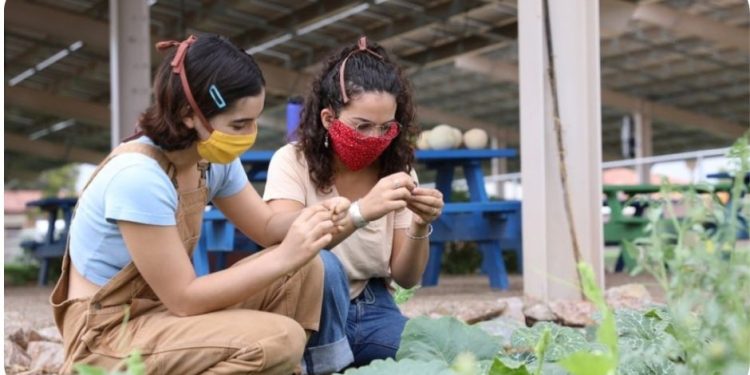Increasing the resiliency of food production during ongoing climate change and bolstering renewable energy production are both fundamental challenges in today’s world.
However, solar energy generation is becoming an increasingly profitable use for cropland, which has led to concerns that solar farms will displace food production.
One possible solution is agrivoltaics – the co-locating of agriculture and solar photovoltaic panels – which can maintain crop production, produce renewable energy, lower water use and increase farm profitability.
Farmers need assistance, however, in determining the crops and locations best suited for agrivoltaic systems, as well as the solar panel design and placement that maintain or increase crop yields.
A new $10 million grant from the National Institute of Food and Agriculture in the U.S Department of Agriculture will allow researchers to study how to best optimize design for agrivoltaic systems in a variety of land types and climate scenarios.
The lead institute on the four-year project, titled “Sustainably Colocating Agricultural and Photovoltaic Electricity Systems,” or SCAPES, is the University of Illinois Urbana-Champaign. Partner institutes include the University of Arizona, Colorado State University, Auburn University, the University of Illinois Chicago and the National Renewable Energy Laboratory. The project is funded through the Agriculture and Food Research Institute Sustainable Agriculture Systems program. The University of Arizona will receive $1.725 million of the grant funding.

Greg Barron-Gafford’s research team includes UArizona undergraduate and graduate students. Barron-Gafford, right, pictured with students Alyssa Salazar, Leandro Phelps-Garcia and Isaiah Barnett-Moreno.
Greg Barron-Gafford, professor in the School of Geography, Development and Environment College of Social and Behavioral Sciences, will be the physical science lead on the project. In 2017, Barron-Gafford’s research team, which includes UArizona undergraduate and graduate students, began growing crops beneath 9-foot solar arrays at the university’s Biosphere 2 facility, where Barron-Gafford is the director of food, energy and water resilience solutions.
Barron-Gafford led the first field-data assessment of agrivoltaics in the United States. He found that agrivoltaics increases the efficiency of both the solar panels and crop production. Water released by plants cools the solar panels, which increases their efficiency and electrical output. Shade from the panels increases plant productivity and saves water, which is especially important as climate change increases the number of areas susceptible to extreme heat and drought, Barron-Gafford said.
The SCAPES project will use a new 1.5-acre Agrivoltaics Learning Lab at the University of Arizona as one of its three agrivoltaics research sites – with the others in Illinois and Colorado – to assess microclimatic and plant responses to the presence of solar panels. The measurement arrays will follow protocols developed by Barron-Gafford.

In 2017, Barron-Gafford’s research team began growing crops beneath 9-foot solar arrays at the university’s Biosphere 2 facility.
“This USDA program is the first time we’re going to have really large installations,” Barron-Gafford said. “We constantly get asked ‘Do all these benefits you’re seeing still happen when you scale this up or look at other forms of agriculture?’ That’s really what this project is doing: Looking at the opportunities and barriers that come with that scale.”
With this grant, Barron-Gafford added, “we’ll be able to measure a lot more food crops at once. And we’ll be able to do a lot more manipulations, like see just how much we can dial back our water use and still meet food needs.”
“Our project will provide a comprehensive analysis of the transformative potential of agrivoltaics,” said Madhu Khanna, principal investigator of the grant and interim director of University of Illinois Urbana-Champaign Institute for Sustainability, Energy, and Environment. “Our goal is to maintain or even increase crop yield, increase the combined – food and electricity – productivity of land, and diversify and increase farmers’ profits with row crops and forage and specialty crops across a range of environments.”

Andrea Gerlak, UArizona professor in the School of Geography, Development and Environment and interim director of the Udall Center for Studies in Public Policy, will be the deputy director of the project’s social science research. Gerlak and colleagues will conduct focus groups with diverse stakeholders, such as farmers, solar industry people and politicians, to learn what drives their decision-making about using agrivoltaics systems and how their opinions change as new research results become available.

The grant also includes an educational component for K-12 children, college students and the public. Moses Thompson, director of the UArizona Community and School Garden Program, and his team have developed a series of protocols and lesson plans for engaging students and the public with school gardens and the Agrivoltaics Learning Labs installed at Rincon High School/University High School and Manzo Elementary School in the Tucson Unified School District. He will support the effort to integrate experiential and hands-on learning at all three SCAPES research sites.
“The ‘Grand Challenges’ pillar of our strategic plan focuses on leveraging our strengths in research to tackle problems at the national and global levels. Ensuring the availability of food through the use of a renewable energy source is an outstanding example of how our researchers are developing innovative solutions to critical problems,” said University of Arizona President Robert C. Robbins. “I am so pleased to see Dr. Barron-Gafford’s cutting-edge work advancing to the next level with this grant from the USDA and I look forward to following him, Dr. Gerlak and Mr. Thompson as this collaborative effort progresses.”
– Lori Harwood, University of Arizona College of Social and Behavioral Sciences
Photo at top: The grant will, in part, support the effort to integrate experiential and hands-on learning at all three SCAPES research sites. Photo: Moses Thompson/UArizona Community and School Garden Program


































